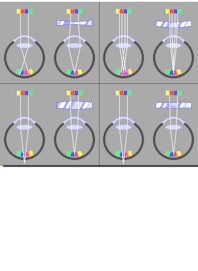Corrective Lenses

Corrective lenses are used to lessen the effects of any number of structural abnormalities that can result in eye problems. Some of these problems are genetic, and others are caused by damage or old age. The most common causes of poor eyesight are merely flaws in the construction of the eye, which prevent it from bringing a clear image to focus on the retina. The most common of these errors are nearsightedness, farsightedness, astigmatism and presbyopia.
Nearsightedness, sometimes called myopia, is a condition in which a person sees near objects more clearly than distant ones. The near vision is not necessarily good; it is just better than the far vision. A cornea that is too curved, an elongated eyeball, or both cause this defect. This causes the light rays from objects far away to be focused some distance in front of the retina and, by the time the light has finished its journey, it has started to spread out, giving a blurred spot of light instead of a sharp image.
Farsightedness, or hyperopia, is the opposite of myopia, with distant vision being sharper than close vision but, in this case, the cornea and lens do not bend the light rays enough, so that they reach the retina before they come into sharp focus-again, giving a blurred focus. Presbyopia has similar effects to those of farsightedness, making near objects appear blurred, but it is a separate condition, usually caused by the gradual failing in the eye's powers brought on by old age. Astigmatism is the irregular shape of the astigmatic cornea, causing the light rays to bend unevenly and leaving a blurred image on the retina.
If the eye's optical system is not working properly, using external lenses, either in the form of eyeglasses or contact lenses can often help it. A more radical method of correcting vision involves surgery on the eye itself.











-new-upper.jpg?auto=format,compress&fit=max&w=262&q=75)




